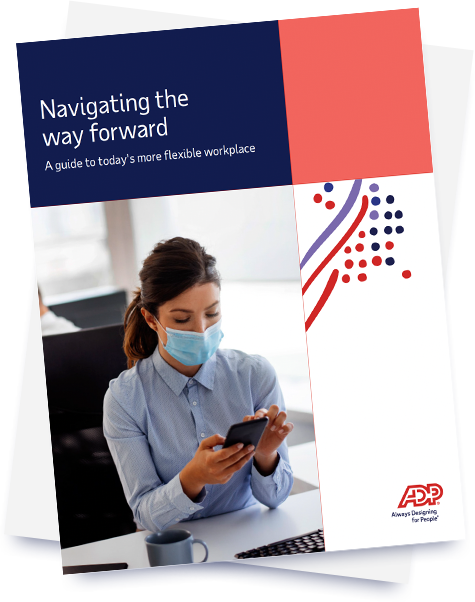As we continue to experience effects of the global health event, employers must plan what’s next for their employees and their businesses. Some are finding it challenging to adapt to flexible work arrangements while complying with a myriad of changing regulations. Complicating matters further, there are no comprehensive guidelines from government authorities that spell out exactly how every business should resume or adapt operations. The following insights from ADP experts serve to fill this gap in knowledge so that employers can implement new policies and make strategic decisions that will help them successfully navigate the way forward.
Flexible workplace policies
Deciding when, whether and how to transition to flexible work requires a multi-disciplinary approach and a review of existing policies and practices. For example, now is the time to make sure that attendance and remote work protocols are updated to reflect current expectations. Any changes in procedure should be clearly communicated to employees with consistent reminders for reinforcement.
New or revised workplace policies must also adhere to all federal, state and local government regulations. One which affects many businesses is the Biden administration’s vaccine mandate. The executive order states that:
- All federal executive branch workers must be vaccinated. This standard is extended to employees of contractors that do business with the federal government.
- All private-sector employers with more than 100 employees will be required to ensure that their workers are either vaccinated or are tested weekly for COVID-19.
- The U.S. Occupational Safety and Health Administration (OSHA) will issue an Emergency Temporary Standard (ETS) to implement this requirement. The OSHA rule will also require employers with more than 100 employees to provide paid time off for the time it takes for workers to get vaccinated or to recover from any ill effects of the vaccination.
- Vaccination requirements will also apply to health care workers at Medicare and Medicaid participating hospitals and other health care settings that receive Medicare or Medicaid reimbursement.
Data security in flexible workplaces
With businesses operating remotely and employees working from home, data fraudsters and scammers have been more active. Even without anyone directly targeting sensitive information, the risk at this time is greater. To help prevent a data breach, employers should be aware of risks in all of the places where they do business. Shoring up supply chain or multi-national payroll and HR with an integrated, cloud-based system can also greatly improve business resilience and information security.
How technology can improve flexibility in the workplace
For HR and payroll departments, the immediate focus of workplace flexibility is highly tactical and operational – people need to be paid, have access to their health benefits and manage their time information – no matter where they may be working. Employers who experience issues in any of these areas may want to upgrade their tools and technology by taking these measures:
- Leverage mobile capabilities and encourage self-service wherever possible to manage work-life virtually.
- Encourage electronic pay options, like direct deposit and paycards, which won’t be affected by office closures and offer greater freedom for underbanked and unbanked employees.
- Integrate time and attendance tools with other HR systems to streamline processes and improve accuracy.
- Implement an HR system that maintains benefits eligibility for all employees, even when their work status changes (flex, part-time hours) or when they leave the organization and are eligible for COBRA.
- Make handbooks available online to keep employees up-to-date on policy changes and procedures for addressing questions.
Supporting teams while they work remotely
With the widespread shift to remote work, employees may need support as they adjust to new conditions. To make a positive impact on engagement and productivity, HR leaders should:
- Be aware of stress
Promoting positive mental health in a work environment often starts with acknowledging the challenges. - Assess productivity expectations
Talk to employees about their workload and expectations. If productivity is lacking, consider offering flexible deadlines or technology that eliminates repetitive tasks so they can get more accomplished. - Recognize that employees are dealing with different issues
Employees may have additional stressors at home, like homeschooling children or caring for sick loved ones. - Foster connection
Overcome the lack of social interaction by using video conferencing, messaging applications and collaboration software. - Communicate health benefits
Sending out a newsletter to remind employees of their coverage and providing links to telehealth services can help people get the support they need.
Drive productivity further with gig workers
By using independent contractors, employers can respond to changing demands for specific skills, experience or expertise, when and where they’re needed. This adaptability, along with the fact that they are faster to onboard then regular employees, makes gig workers ideal for ideal for short-term tasks and projects. Businesses that become accustomed to working with these individuals will have a more agile and resilient workforce and may be better positioned to succeed in the future economy.

